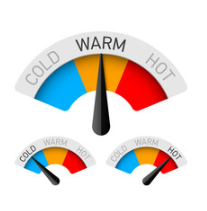Men and Women Face Off Searching for the Perfect Room Temperature

In a recent article in the Wall Street Journal, The Numbers columnist Jo Craven McGinty reviewed various studies that examined the effects of temperature on the sexes. And because TRC is always interested in anything thermostat-related and their impact on people, we found some of the conclusions fascinating.
It also addresses the age-old question of why, according to popular belief, women appear to be colder than men.
Let’s start with the search for the perfect temperature.
“What we recommend for summer room temperature is around 23 degrees Celsius to 28 degrees Celsius,” the equivalent of 73.4 degrees Fahrenheit to 78.8 degrees Fahrenheit,” according to McGinty, quoting Bjarne Olesen, a past president of ASHRAE.
When the Lawrence Berkeley National Laboratory reviewed 95 office buildings in 2009, McGinty noted, most had temperatures lower than those Olesen recommended.
The study concluded that inching the temperature upward could improve health and save energy, too, according to McGinty.
Women seem to prefer higher temperatures than men, and as a result, they perform better.
Last year, the University of Southern California and the WZB Berlin Social Science Center in Germany conducted a test on 543 university students to study the effects of room temperature. “Women accomplished more on math and verbal tasks when the temperature was higher, while men performed better when it was lower,” according to McGinty.
That leads to the obvious question: Why? It appears that because women have higher metabolic rates and their body surface to body mass has a larger ratio, this results in more significant heat loss.
She quotes Boris Kingma, a researcher at TNO: the Dutch Institute of Applied Technology and at Copenhagen University. “If two people are the same height, weight and age, if you only change whether it’s a male or female, you expect a 10% to 20% difference in metabolic rate,” Kingma explains. “If you have a higher body surface area to lose heat relative to the volume available to produce heat, you tend to lose heat more easily and are more sensitive to cold.”
You might want to use that explanation the next time there is a battle in your office or warehouse over the thermostat setting.
In fairness, McGinty also said that other factors might affect how you respond to room temperature, including age, body composition, fitness and hormones.
It would seem sensible that when contractors install a new thermostat (and return any mercury-containing ones to TRC via their wholesaler), they suggest temperatures that Olesen recommends.
His 80% satisfaction rate for most people who keep a setting of 73.4 to 78.8 degrees Fahrenheit should engender a truce over the thermostat battle. For the 20% who still prefer it warmer or cooler, well, someone might have to add or decrease the amount of clothing they wear to find that perfect comfort level.

